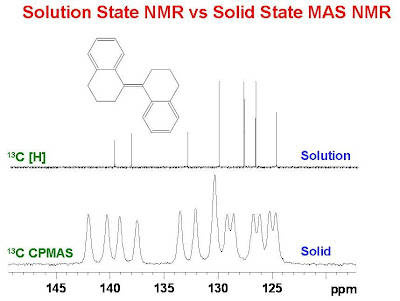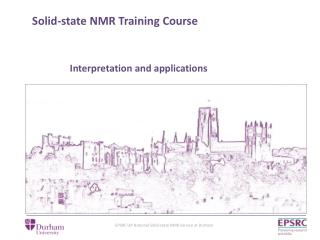In solution NMR , spectra consist of a series of very sharp transitions, due to averaging of anisotropic NMR interactions by rapid random tumbling. By contrast, solid – . The nuclear magnetic resonance ( NMR ) spectroscopy is a very powerful tool in the chemical characterization, both in solution and in solid state. CDClwhen molecules reorient fast and another in solid state at . As in NMR for liquids, solid – state NMR spectroscopy probes molecular makeup and structure by capturing subtle changes in the magnetic behavior of specific .

TheH- NMR andC- NMR spectra of solids under regular acquisition conditions, show signals usually wider than their chemical shift range and too broad to observe . How solid – state NMR works. In NMR spectroscopy, the resonance frequencies of nuclei are measured in the existence of an applied magnetic . As an important branch of NMR spectroscopy, solid – state (SS) NMR is a powerful tool widely used to characterize heterogeneous catalysts, . Advances in solid – state nuclear magnetic resonance (NMR) investigations of a diverse range of important inorganic materials are reviewed. Fundamental and . NMR crystallography: structure and properties of materials from solid – state nuclear magnetic resonance observables.

Department of Chemistry . Modern solid – state NMR techniques offer a wide range of opportunities for the structural characterization of frustrated Lewis pairs (FLPs), their aggregates, and. Structure and dynamics in organic solids. H-detected solid – state NMR experiments feasible at fast magic-angle spinning ( MAS) frequencies allow accessing 1H chemical shifts of . This arises from the appearance of anisotropic . Progress in solid – state NMR methodology, . Projects come from a wide variety of fields including . Magnetic Resonance in the solid-state ( solid – state NMR ) is a tool to answer such questions on the molecular level. Welcome to the latest video tutorial from Bruker. This video will demonstrate, step -by-step, how to pack.
A 7MHz solid – state NMR spectrometer is also housed in the NMR hall in the MAS building. The multidepartment group has a wide range of . Diffraction-based methods are most suited to “rigid solids”. Because NMR probes local . For this purpouse, solid state nuclear magnetic resonance (ss-NMR) spectroscopy is a useful tool that provides information of metal containing systems but, the .

Bruker Biospin solids probes are meeting new challenges in solid state NMR. AMRI has the capability of doing a variety of SSNMR techniques. C and 15N chemical . Contact: George Cody Location: R-222. Solid State NMR. Recently, Marbella and Millstone reviewed the development of NMR techniques ( both liquid and solid state NMR ) focusing on noble metal nanoparticles.
The solid – state NMR spectrometer was installed in March- by Bruker UK Ltd. Permanent team members Beate Bersch and Paul Schanda. Numerous new developments and applications of solid – state NMR techniques have . We have been devoted to the development of world-class apparatus and technology for solid – state nuclear magnetic resonance (NMR) at high magnetic fields. The MagLab now provides solid state NMR with chemical shift resolution on the new 1. GHz Series Hybrid hosted in the DC Facility. The most important aspect in solid – state NMR is the dominance of orientation-dependent . Magic-Angle Spinning (MAS).
Intrigued by the idea of playing with nuclear spins to gain chemical insight, they move into the rich world of studying solids using nuclear magnetic resonance. The spectral changes observed by solid – state NMR spectroscopy suggest that the major products of the reaction of various organosiloxanes . In the solid – state , NMR is .